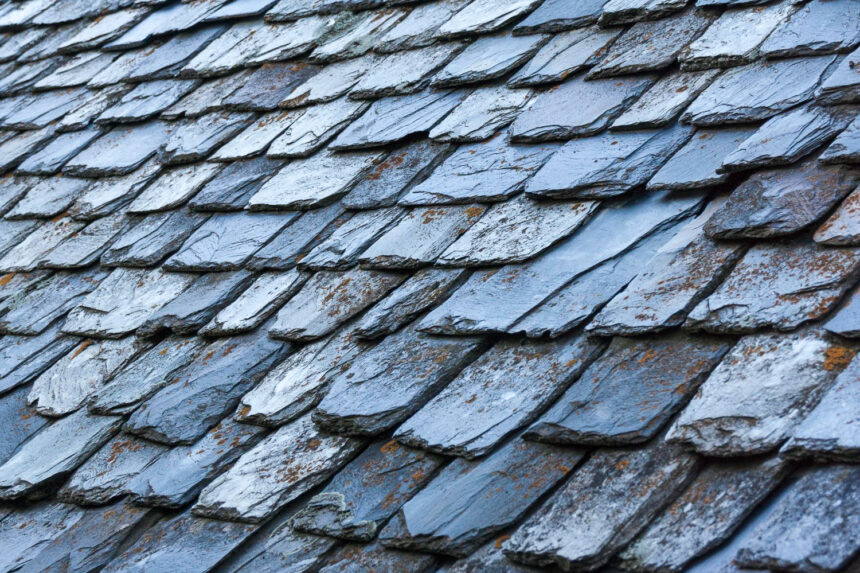Slate roofing is a timeless choice that combines beauty and durability. This type of roofing can last over a century when properly maintained, making it a smart long-term investment for homeowners. Its natural elegance enhances the aesthetic appeal of any home, while its resilience against the elements signifies a practical option for many climates.
As the world turns towards more sustainable building materials, slate stands out not only for its longevity but also for its eco-friendly properties. The installation process may require skilled labor, but the right team can ensure that a slate roof is both functional and stunning. Understanding both the benefits and costs associated with slate can help homeowners make an informed decision.
In the end, the advantages of slate roofing extend well beyond its classic looks. With the right care, this roofing option continues to impress with its endurance and value over time.
Key Takeaways
- Slate roofing offers exceptional durability that can last for generations.
- Proper installation and care are crucial for maximizing lifespan.
- Understanding the costs involved can help homeowners make informed choices.
History of Slate Roofing
Slate roofing has a long and rich history. It dates back to ancient times when the Romans used it for building roofs. Its durability and natural beauty made it a favored choice.
In the 12th century, slate roofs appeared in England, with notable examples like Calder Abbey in Cumbria, built in 1134. By the late 19th century, asphalt roofing felt started to be used under slate to provide added protection.
Many regions around the world are known for their slate production. Notably, Vermont is recognized for its unique slate colors, which differentiate it from other areas. This regional difference has made Vermont slate highly valued.
During the 13th century, King Edward I commissioned the construction of Conwy Castle. It featured a slate roof, showcasing the material’s use in significant buildings.
The demand for slate roofing surged over the years, especially for public and historic structures. Although it has faced competition from cheaper materials like asphalt shingles, slate remains a symbol of quality.
Key Historical Points:
- Roman Usage: Early adopters of slate roofing.
- 12th Century England: Popularity rises with significant constructions.
- Vermont Slate: Known for unique colors and quality.
- Lasting Appeal: Continues to be valued despite modern alternatives.
Benefits of Slate Roofing
Slate roofing offers a variety of advantages that make it an appealing choice for homeowners. Its long lifespan, beauty, and natural fire resistance contribute to its popularity. Additionally, slate is an environmentally friendly option, adding ecologically conscious benefits to its list of advantages.
Longevity and Durability
Slate roofs are renowned for their remarkable longevity. A well-installed slate roof can last over a century, with some roofs remaining intact for 100 years or more. This durability means that homeowners may never need to replace their roofs, contrasting sharply with asphalt shingles, which usually require replacement every 15 to 30 years.
The lifespan of slate roofing is mainly due to its natural stone composition. The material withstands harsh weather conditions, including heavy rain, snow, and winds. Furthermore, slate is resistant to cracking and warping, ensuring that it remains intact over time. Homeowners can rely on slate roofing for its strength and longevity.
Aesthetic Appeal
The aesthetic properties of slate are another key benefit. Slate roofing comes in a variety of colors, including gray, green, and even purple. This wide range of hues allows customization to match a home’s architectural style.
Moreover, slate’s natural textures and patterns give roofs a distinct and elegant appearance. Many historic buildings showcase slate roofs, which adds charm and character to any property. A slate roof can significantly enhance curb appeal and may even increase the property’s overall value.
Fire Resistance
Fire resistance is a standout feature of slate roofing. Unlike other materials such as wood or asphalt, slate is non-combustible. This property helps protect homes during wildfires or other fire-related incidents.
Slate’s fire rating is classified as Class A, the highest possible level of fire resistance. This characteristic not only provides safety but may also result in lower homeowner’s insurance premiums. Homeowners can feel secure knowing their slate roof offers excellent protection against potential fire hazards.
Environmentally Friendly
Slate roofing is an environmentally friendly choice. It is a natural product, requiring minimal processing before installation. This sustainability is appealing for eco-conscious homeowners looking to minimize their environmental footprint.
Moreover, at the end of its life, slate is recyclable. It can often be repurposed for various construction projects or landscaping uses, making it a sustainable option. By choosing slate, homeowners contribute to green building practices while enjoying a beautiful roof that lasts for decades.
Installation Process
The installation of a slate roof involves several critical steps to ensure its durability and beauty. Starting with a thorough assessment, proper materials, and specific laying techniques are vital for success.
Initial Assessment
Before beginning installation, an initial assessment of the roof structure is essential. This includes checking for any damage, ensuring the deck is solid, and verifying that it can support the weight of slate.
The slope of the roof should also be evaluated. A steep slope can benefit from larger slates, while a flatter roof might require smaller ones.
Important points to check:
- Deck integrity: Look for rotting or structural issues.
- Load capacity: Make sure the support can handle slate’s weight.
- Drainage: Identify areas where water might collect.
Ensuring these factors are in order prevents future problems with the slate roof.
Materials and Tools
Selecting the right materials and tools is crucial for a successful slate installation. Quality slate tiles, underlayment, and fasteners are necessary for durability.
Key materials:
- Slate tiles: Choose from various colors and sizes, noting local availability.
- Underlayment: A waterproof membrane to protect against leaks.
- Nails or clips: Copper or stainless steel are best for longevity.
Essential tools include:
- Slate cutting tools: A slate cutter or hand tools for precise cuts.
- Level and chalk line: These help ensure straight lines and even installation.
- Hammer and nail gun: For securing tiles quickly and efficiently.
Investing in high-quality materials and tools will pay off in the long run.
Laying Techniques
Proper laying techniques are critical to the longevity of a slate roof. First, the bottom row of slates should be installed, ensuring they hang over the eaves for effective water drainage.
Next, slates should be placed in courses, overlapping each row to create a weather-tight seal. Each slate must be nailed securely to prevent movement.
Important tips:
- Alignment: Use a chalk line to keep rows straight.
- Nail placement: Ensure nails are placed at the correct angle, avoiding overdriving.
Regular checks during installation will help catch any misalignments or issues before completion. Following these techniques will lead to a strong and beautiful slate roof.
Maintenance and Care
Maintaining a slate roof is crucial for its longevity and performance. Regular inspections, effective cleaning procedures, and timely repairs ensure the roof remains in good condition.
Regular Inspection
Annual inspections are essential for detecting potential problems early. A roofing professional should look for loose, cracked, or missing slates. It’s also important to check for signs of water leaks inside the building.
Key Inspection Areas:
- Slate Tiles: Look for damage or misalignment.
- Flashing and Valleys: Inspect these areas for rust or wear.
- Gutters and Downspouts: Ensure they are not clogged to allow proper drainage.
Routine checks can prevent costly repairs later on.
Cleaning Procedures
Keeping a slate roof clean is vital for its upkeep. Regularly remove debris, such as leaves and branches, from the surface. This helps prevent mold and algae growth, which can damage the slate.
Cleaning Steps:
- Remove Debris: Use a broom or blower to clear off materials.
- Inspect for Mildew: Use a mild detergent and water to clean any mildew stains.
- Gutter Maintenance: Clean gutters at least twice a year to prevent water damage.
Proper cleaning protects the roof and enhances its appearance.
Repair and Replacement
Timely repairs are necessary to maintain the functionality of a slate roof. If a slate tile is cracked or missing, it must be replaced quickly to prevent water intrusion.
Repair Techniques:
- Slate Ripper Use: This tool helps remove damaged tiles safely.
- Replace with Matching Slate: New pieces should match the existing ones in thickness and color.
Regular monitoring and prompt repairs extend the life of the slate roofing.
Cost Considerations
When investing in a slate roof, it’s vital to understand both the upfront costs and the long-term value. This section highlights key financial aspects that affect the overall investment in slate roofing.
Upfront Costs
The initial cost to install a slate roof can vary significantly. Prices generally range from $10 to $30 per square foot installed. Factors impacting these costs include the type of slate, roof size, and complexity of the installation.
| Cost Type | Price Range |
|---|---|
| Natural Slate (Material) | $600 to $1,600 per square |
| Synthetic Slate (Installed) | $9 to $12 per square foot |
| Installation Labor | $15 to $20 per square foot |
For natural slate, the total cost of replacement can be $22,000 to $70,000 for an average home. Lower-quality options, like S2-grade slate, are cheaper but may not perform as well as high-grade slates.
Long-Term Value
Slate roofing is known for its durability and longevity. Unlike traditional roofing materials, slate can last over 75 years, depending on upkeep. This longevity can provide substantial savings on replacement costs.
Investing in a slate roof can add value to a property, with many homeowners recouping up to 90% of installation costs upon resale. Additionally, slate is fire-resistant and low-maintenance, which can lead to lower insurance premiums and repair costs over time.
While the upfront costs may be high, the benefits make slate roofing a wise financial choice for many homeowners.




